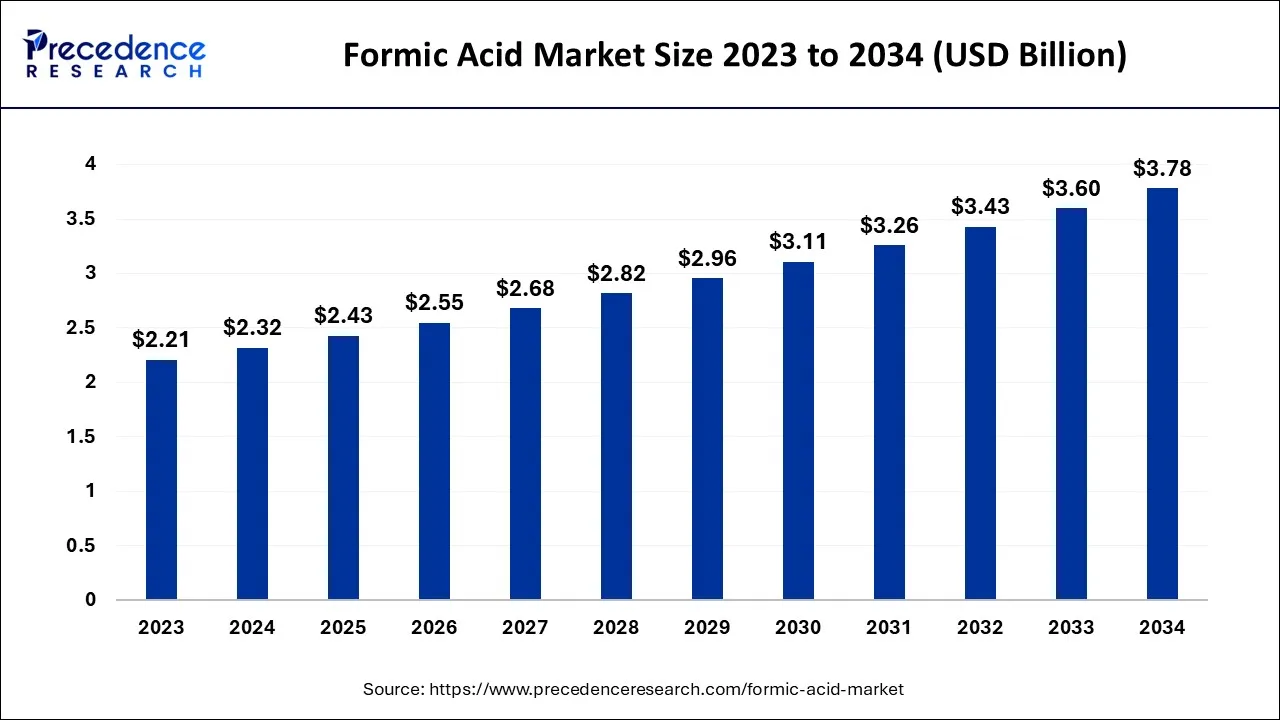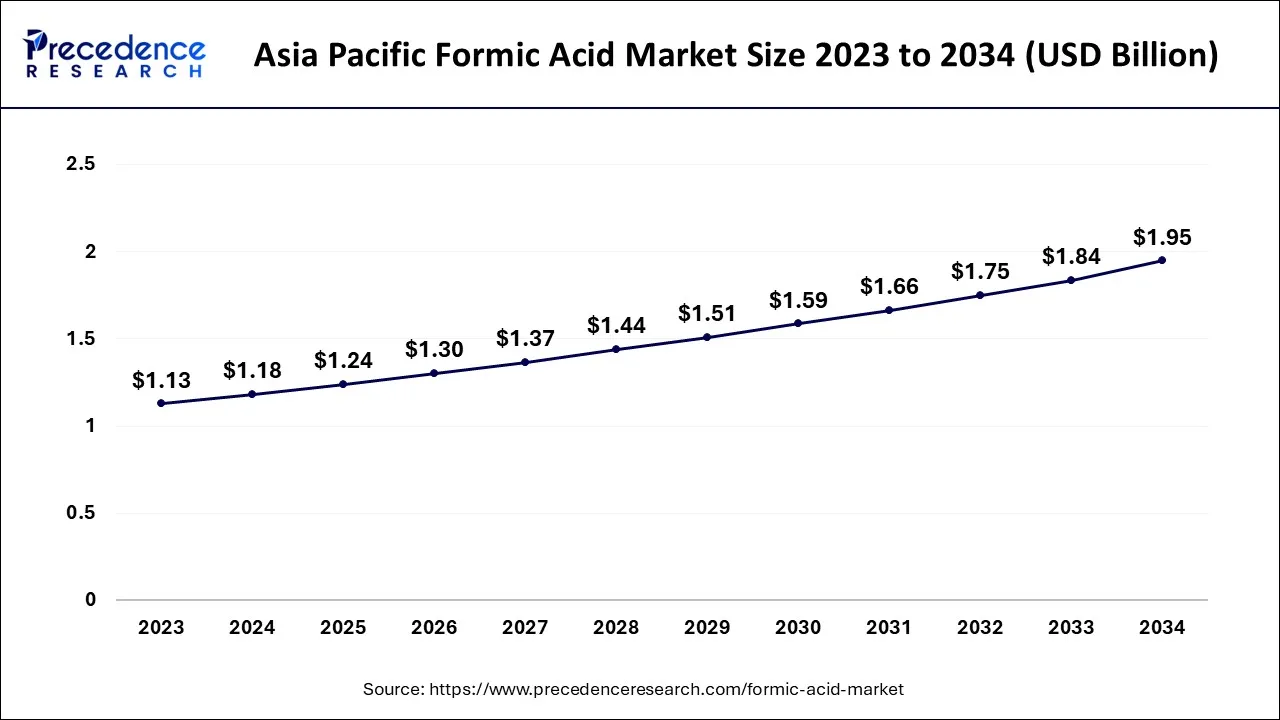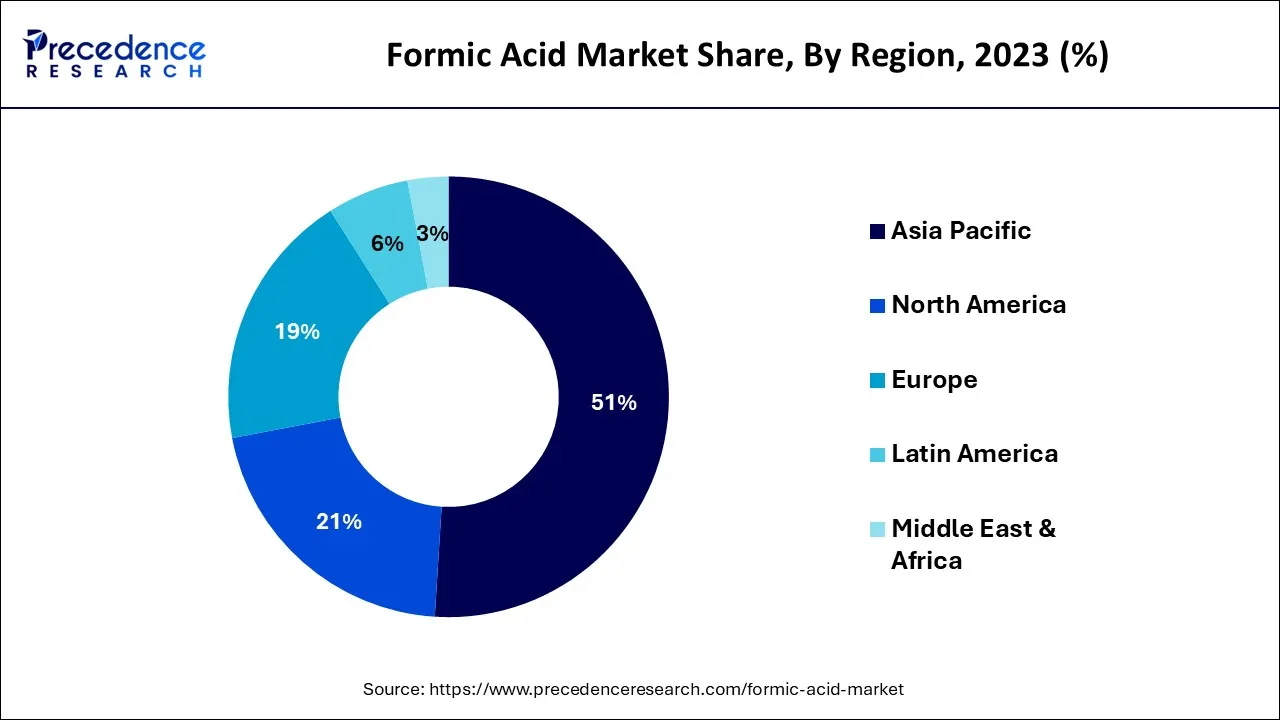September 2024
The global formic acid market size accounted for USD 2.32 billion in 2024, grew to USD 2.43 billion in 2025, and is expected to be worth around USD 3.78 billion by 2034, registering a healthy CAGR of 5% between 2024 and 2034. The Asia Pacific formic acid market size is predicted to increase from USD 1.18 billion in 2024 and is estimated to grow at the fastest CAGR of 5.11% during the forecast year.
The global formic acid market size is expected to be valued at USD 2.32 billion in 2024 and is anticipated to reach around USD 3.78 billion by 2034, expanding at a CAGR of 5% over the forecast period 2024 to 2034.

The Asia Pacific formic acid market size is exhibited at USD 1.18 billion in 2024 and is projected to be worth around USD 1.95 billion by 2034, growing at a CAGR of 5.11% from 2024 to 2034.

Asia Pacific is expected to be the largest marketplace for formic acid during the forecast period. Asia Pacific is considered a hub for agricultural activities, the agricultural sector is one of the leading segments in the formic acid market; this offers a lucrative opportunities for countries in Asia Pacific to grow during the forecast period.
The continuous growth of formic acid market is attributed to the rising expansion of textile, rubber, leather and pharmaceutical industries, especially in India and China. The major market players are interested to draw high investment in China due to its lower labor cost and lower capital and rapidly growing market. It is expected as a major growth opportunity over the anticipated period.

On the other hand, North America showed a significant increase in terms of revenue in 2023, the region is expected to witness a noticeable growth during the forecast period. The growth of formic acid market in North America is driven by the presence of large-scale producers of formic acid in the region. Producers of formic acid including BASF and Geismar are headquartered in North America. Additionally, the expansion of end users along with the rising investments in new manufacturing plants are expected to open a plethora of opportunities for the market’s growth during the forecast period.
Europe is another emerging market for formic acid, the rising demand for preservatives for livestock feed and expansion of leather-based products industry in the region are held as major factors for the growth of formic acid market in Europe.
Formic acid is an organic compound that is acidic in nature. Formic acid is a colorless and pungent liquid. The formic acid market refers to the global market that revolves around the production, distribution, and consumption of formic acid. The formic acid market is the worldwide market that comes under the chemical industry. Formic acid is predicted the growth during the anticipated time period. Formic acid can be used in animal feed, silage additives, added preservatives, textiles, rubbers, pharmaceuticals, etc. Leather, rubber, and added preservatives become the largest growing application resulting in the growing demand in consumers for it.
The Formic acid market is anticipated to expand during the forecast period, with the rising demand for formic acid from multiple industries. Formic acid could be used in various industries like pharmaceuticals, rubber, leather preservatives many others. Formic acid can be used as a preservative in processed food and animal feed also. Since formic acid had antibacterial properties results it is used as a food preservative in packaged food. The growing demand for processed food in the market results in higher demand for formic acid in the market.
The rubber and textile industry also gained the attraction of the market. The higher demand for rubber in tire manufacturing and various consumer goods industry boost the market. However, the rising fashion trends among people result in greater demand in the textile segment. Additionally, animal feed additives are also one of the major factors for the growing demand of the formic acid market.
Since formic acid had great antibiotic properties in it, rising consumption of non-vegetarian products and poultry products resulted in the growing demand in the market. The anti-bacterial properties of formic acid make it ideal as an animal feed additive, the growing demand for animal feed additives from global agricultural sector is expected to act as a growth factor for the development of the formic acid market.
| Report Coverage | Details |
| Market Size in 2024 | USD 2.32 Billion |
| Market Size by 2034 | USD 3.78 Billion |
| Growth Rate from 2024 to 2034 | CAGR of 5% |
| Largest Market | Asia Pacific |
| Base Year | 2023 |
| Forecast Period | 2024 to 2034 |
| Segments Covered | Application, End-User, and Region |
| Regions Covered | North America, Europe, Asia-Pacific, Latin America and Middle East & Africa |
Rising demand from agricultural sector
The expanding agricultural activities along with the rising demand for formic acid-based products from the agricultural sector is observed to act as a driving factor for the growth of formic acid market. Formic acid is used as an antibacterial feed and antibacterial chemical defense in the agricultural sector. For several years, formic acid is a major part of the agricultural sector. Especially it is used in animal feed and silage, both liquid and solid form of the formic acid is considered as safe. It can be used with all species of animals, consumers, and the environment. For a number of years, for animal nutrition the application of formic acid as a feed. The market value for the preservatives present in silage and antimicrobial for animal feed is expected to increase as demand rise.
In poultry farming, formic acid is sprayed on feed to kill Salmonella bacteria. In the agriculture segment, formic acid is applied to the fresh hay to stop or halt decay, so it can allow feed for a longer survival period. Additional formic acid used a treating mite infection on crops because it harms mites. Formic acid act as an antibacterial and preservative for livestock feed.
High concentrations of formic acid result in restriction of the market
While there are many advantages of the formic acid, the limitations associated with the use of formic acid are observed to restrain the market’s growth. High concentrations of formic acid result in danger. The excess amount of formic acid or a high concentration of formic acid results in hazardous fumes, it may because skin issues like allergic reactions on the skin, skill itching, eye injury, and heartburn, and it also can harm the mucus membrane of the throat and mouth. Continuous exposure to concentrated formic acid may cause chronic diseases like liver and kidney damage. Direct intake of concentrated acid cause many problems with the stomach and digestive system, pain, and nausea. Hence formic acid is restricted from some of the regions because of its high toxicity in nature and may hamper the overall growth of the market.
The power industry becomes the future prospect for formic acid
Formic acids are the simplest form of acid that can be found naturally and can be formed in the laboratory. It can be used in various sectors of the pharmaceutical industry. The recent development in formic acid it can be used as a convertible source of the hydrogen storage process. Formic acid is useful to minimize global warming by the production of formic acid in atmospheric carbon dioxide will minimize the carbon dioxide in nature. Formic acid is used as a sustainable carbon monoxide source. Formic acid can be seen as a liquid storage version of carbon monoxide in the form of liquid, and these can be directly used in the chemical value chain.
Animal feed holds the largest market share in terms of revenue share in the forecast period. Formic acid is mainly used in animal feed for maintaining the nutritional level of agricultural animals. Though formic acid had great antibacterial properties, it prevents the feed from insects and bacteria for better feed digestion and feed conversion. The animal feed segment expects growth cause of agriculture demand.
Silage is expected a significant interest in the formic acid market. Silage production is important for restricting the proliferation of pathogens. And can be useful for preventing growth of the silage bacteria or microorganisms.
The agriculture segment is anticipated to hold the largest market size in the end-use industry in the predicted timeframe. Formic acid is one of the major constituents in the agriculture sector. Because of its antibacterial properties, it can be used in the various sectors of agriculture. From used as a spayed on the crop for their longer lifespan to poultry farming applying to feed to kill harmful bacteria.
Pharmaceuticals are one of the important industries that had the hands-on formic acid. Formic acid has antibacterial as well as preservative properties in it, so it can be used as a pharmaceutical chemical or for the preservation of drugs.
Segments Covered in the Report
By Application
By End-User
By Geography
For inquiries regarding discounts, bulk purchases, or customization requests, please contact us at sales@precedenceresearch.com
No cookie-cutter, only authentic analysis – take the 1st step to become a Precedence Research client
September 2024
March 2025
December 2024
August 2024